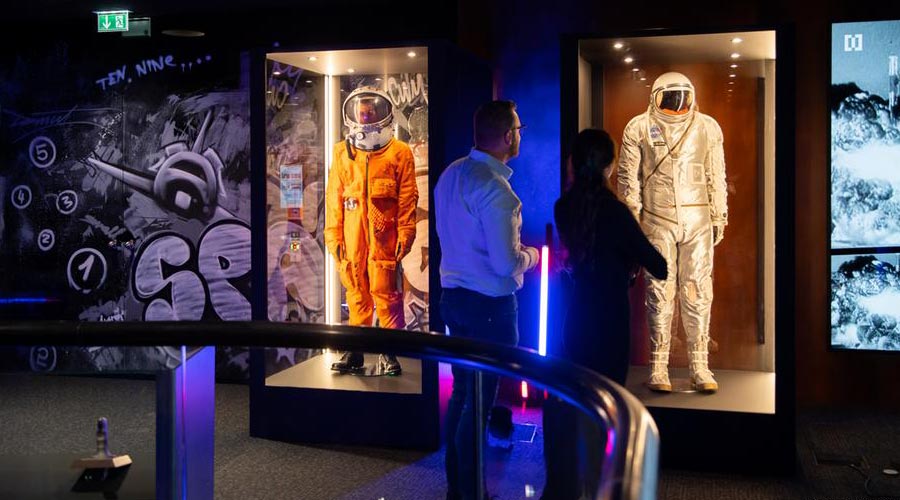For more than 40 years, Berlin was on the front line of the Cold War. Here is where GDR dissidents planned their escape to the West, where American and Soviet spies plotted and schemed, where chancellors, presidents and first secretaries on both sides of the Iron Curtain performed acts of political brinkmanship.
Now, Germany's capital is getting a museum that aims to bring the history of the Cold War to life.
The Cold War Museum, located on Unter den Linden 14, just a few hundred meters from where the Berlin Wall once stood, is the first of its kind worldwide.
While other institutions cover aspects of the same history - the Stasi museum in Leipzig for example, which looks at East Germany's notorious secret police - the goal of the Cold War Museum is to provide an interactive, and entertaining, overview of this critical period for the ordinary visitor, with no previous reading required.
After entering through a symbolic Iron Curtain that covers the front wall of the museum - shot through with holes and bearing the images of Cold War politicians from Harry S. Truman, Winston Churchill and Joseph Stalin through Helmut Kohl, Mikhail Gorbachev and Ronald Reagan - visitors can wander through an exhibit taking a broad stroke approach to history.
History revisited through virtual reality
In sections on Espionage, the Space Race, the Vietnam War, and Nuclear Disarmament, among others, you can tap your way through historical videos and dramatic reconstructions of key moments in the Cold War.
Don a virtual reality headset and you're transported back decades to a divided Berlin. You can follow the (recreated) experience of East German border guard Hans Conrad Schumann as he defects to West Berlin shortly before the Berlin Wall is built, by jumping over a barbed wire barricade, a moment captured in a world-famous photo for Life Magazine.
Visitors can sync their smartphones to most of the exhibits to hear original eyewitness reports from the time or set up augmented reality displays.
A museum for the younger generation
The high-tech approach comes from Cold War Museum CEO Carsten Kollmeier and CFO Harald Braun, the team behind Berlin's popular German Spy Museum, and is designed to appeal to younger visitors, particular ones with no memories, and few associations, with the Cold War.
"My hope is that we can reach more than the typical, older museum visitor and really have a cross-generational appeal," Kollmeier says, "the grandson, born after the Cold War, attending with his grandfather, who lived through it."
Despite all the flashy tech, there is still plenty to appeal to history geeks and old-school museum heads. Bernd Stöver, professor of international history at the University of Potsdam and author of several books on the Cold War, headed up the advisory committee that accompanied the design, making sure everything in the exhibition is informed by the latest historical research.
From missiles to spacesuits
Among the artifacts on display is a Soviet-era S75 rocket - the ominous missile hangs over the entrance - of the sort used to shoot down American pilot and CIA spy Garry Powers over the Soviet Union in 1960, an event that triggered an international incident (and is depicted in Steven Spielberg's Oscar-winning "Bridge of Spies").
There's one of the Telex machines that provided a direct link between Moscow and Washington during the Cuban Missile Crisis and Cold War-era spacesuits from both NASA astronauts and Soviet cosmonauts.
A sealed jar contains a "scent sample," a cloth soaked with the odor of arrested dissidents that the Stasi used to train dogs to identify and track those opposed to the East German regime.
Echoes of today's war in Ukraine
Russia's war on Ukraine, which many have seen as an act reigniting the Cold War, is nowhere to be seen in the current exhibit - the museum was designed long before the February 24 invasion - but current events in Kyiv, Kharkiv and Mariupol give a new urgency to the history on display here.
The Iron Curtain at the museum's entrance, notes Sergei Tchoban, the Russian-born, Berlin-based architect who designed the Cold War Museum, was created by a Ukrainian graphic artist.
And several design elements - from the museum's blood-red floors to a life-sized model of a nuclear bomb that hangs precariously next to the coat check - evoke the clear and present dangers of the last time Russia was at war with the West.
As Tchoban notes: "It's a history that should never be repeated."
Berlin's Cold War Museum opens to the public on November 26.










